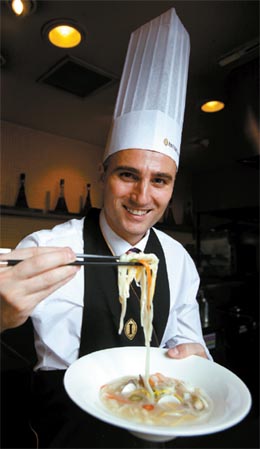For CEO, kalguksu is a testament to Korea’s culinary sophistication

Eric Leger, president and chief executive of Schneider Electric Korea, holds up a bite of kalguksu, or handmade noodles in seafood broth. By Jeong Chi-ho
The most recent dish Leger, 38, cooked with his daughter and wife was spaghetti vongole - spaghetti pasta with clams - which he boasted was the most delicious dish he had recently eaten.
“Cooking is very simple, and cooking is always a nice event for a young girl like my daughter,” he said.
Next up for Leger is the Korean seafood dish kalguksu, or handmade noodles in seafood broth. “The combination of seafood and vegetables bring a very mild flavor, suitable for a European taste like me,” Leger said.
The rich flavor of kalguksu, Leger also said, reminded him of Korea’s collectivist culture.
“Cooking and eating is collective and I love that [part of Korean] culture. And a part of a country’s identity must be in its cuisine,” said the CEO.
“You want to keep what makes you different, just like what Korea is doing with its own cuisine,” he said. “If your food becomes the same as all the others, then [it will] become ... junk food.”
Leger said Korea is a sophisticated country in terms of social protocol and manners, and its cuisine is a testimony of its etiquette and attitude.
It was in 2008 - the same year when Leger was appointed president and CEO of Schneider Electric Korea - when he had his first bite of kalguksu. “I was in Busan visiting the company’s regional office when I tried kalguksu for the first time,” he said. “I’d always told my team that I love seafood dishes and they took me to a restaurant selling seafood kalguksu. And ever since, I have loved the dish.”
While talking about his love for kalguksu and Korean food in general, Leger was greeted by chef Jang Yong-jeon from the Grand InterContinental Seoul in Samseong-dong, Gangnam district. Leger donned his chef’s hat and apron before he and Jang dove into the kalguksu recipe.
They mixed flour with water and a pinch of salt to make the dough for the handmade noodles. They cut zucchini and mushroom into thin pieces and prepared the squid.
No stranger to the kitchen, Leger moved with confidence.
“The difficult part comes now,” Jang said, referring to making the noodles from scratch and getting the noodles to just the right thickness. He demonstrated the procedure by flattening the dough using a roller and folding it into layers before cutting thin stripes.
After carefully observing Jang, Leger took his best shot. Leger was then advised to put different types of seafood and the noodles into the stock, which they had prepared beforehand.
“The taste of the soup itself is very strong,” said Leger after a quick taste. “The strong taste is probably coming from the dry fish.”
Leger predicts kalguksu could one day be popular in Europe as people there often eat seafood. Plus, he said all the ingredients to make kalguksu already exist in Europe. “Though, the seaweed could be a challenge.”
“It’s not always easy to find the specific spices and ingredients for other Korean cuisines,” he said. “That could be one of the big obstacles in globalizing Korean food because we don’t traditionally use the same spices in any other cuisines.”
Another way to make Korean food more popular on global shores is to customize the taste for foreigners’ palates, but not to the point where dishes lose their authenticity.
“It’s a bit hard-core when you have radish kimchi offered to foreigners,” he said. “Some people eat it, but many would think it’s too spicy. It’s better to make it a bit milder, and adapt the way Chinese do it.”
In Shanghai, where Leger lived for two years, he noticed that “Chinese restaurants in Europe do not have the same taste [they do] in Shanghai. It’s not the same authenticity, but it’s more acceptable to the taste of foreigners.”
And in Korea, Leger says that he’s noticed that “the experience is very rich in Korean food,” and he thinks “there is no reason why Korean food cannot be popular.”
Leger says that many of his friends go for Korean soup and barbecue and that there are more Korean restaurants in Paris than ever. “It will be popular, and it is indeed getting more popular,” he said.
Eric Leger
* President, CEO of Schneider Electric Korea since 2008
* Country manager Schneider Electric Sri Lanka/Maldives
* China manager for Schneider Electric Asia Pacific’s international sourcing team
* Finance, logistics, MIS manager for Schneider Electric Philippines
By Lee Eun-joo [angie@joongang.co.kr]










with the Korea JoongAng Daily
To write comments, please log in to one of the accounts.
Standards Board Policy (0/250자)